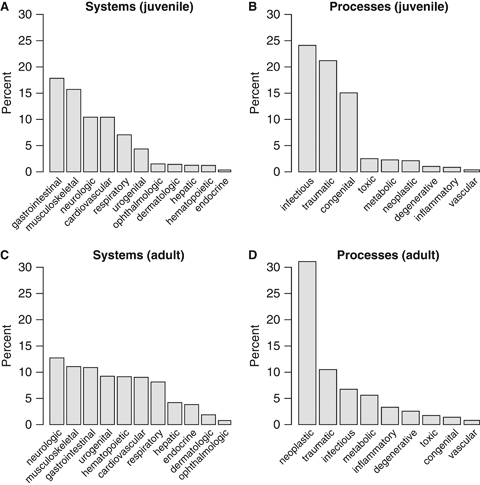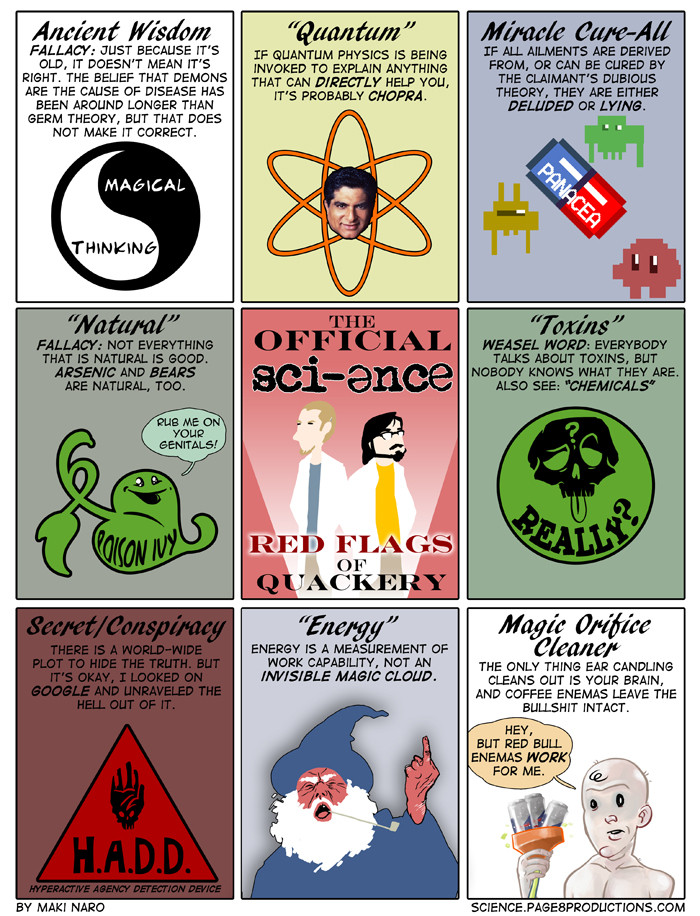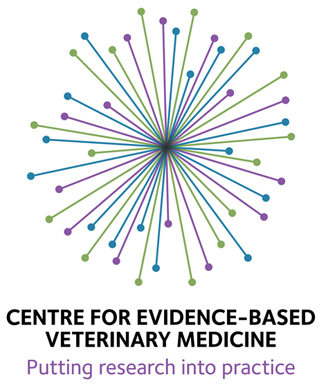It might therefore be useful to get some idea of whether or not the claims of great popularity for CAM treatments are true. If they are not, fruitless debates about the probative value of such popularity could potentially be avoided, and it might be possible to diminish the allure associated with the belief that “everybody’s doing it.”
Surveys of CAM Use
It is difficult to find good quality objective data on the popularity of particular CAM interventions, and many of the surveys that have been done are potentially misleading. For example,. the 2007 CDC National Health Interview Survey (NHIS) is widely cited as showing that about 30% of Americans use CAM therapies. A careful look at the details of this survey, however, shows that many of the supposed CAM therapies are really relaxation or exercise practices, such as massage and yoga, not medical therapies. Chiropractic is the only medical therapy generally classified as alternative that was used by more than 10% of people in the survey. And that was primarily for idiopathic lower back pain, an indication for which it is generally accepted, even by skeptics such as myself, as having some demonstrated benefit, about equal to standard medical interventions. These usage numbers haven’t changed in decades, which belies the notion that CAM is growing in popularity.
Similarly, much was made by the media of a recent CDC survey that supposedly showed widespread use of CAM therapies in hospice care facilities. A close analysis of this survey, also shows that most of the therapies listed are not truly alternative medical interventions and that fewer than half the facilities surveyed offered true CAM therapies, and fewer than 10% of patients in those facilities actually employed the CAM practices offered.
Studies of Acupuncture Use
I thought it might be useful to look at some of the data concerning the popularity acupuncture, since it is probably the most widely used and accepted CAM therapy after chiropractic, and there have been a few interesting studies in this area. There are certainly no comprehensive, high-quality data concerning how many people use acupuncture, for what indications, and with what sort of beliefs in its underlying theory or effectiveness. My purpose is not to make a definitive statement about how popular acupuncture is but simply to take a small step beyond vague impressions and unsupported claims about the popularity of this intervention and look at what research there is and what insight, if any, these numbers might give us.
The 2007 NHIS data indicated 6.5% of Americans had reported ever using acupuncture. Of these, 22% had seen an acupuncturist in the last 12 months. 25% of those who had tried acupuncture had done so once, and 70% had seen an acupuncturist fewer than 5 times. The vast majority of those who had seen an acupuncturist had done so for some kind of pain, primarily arthritis and other orthopedic pain, headaches, or fibromyalgia. About 40% of the people who reported using acupuncture for a specific condition specifically reported not using conventional therapies for that condition, while 20-40% reported using some kind of conventional medical therapy for the same condition.
It is often argued that lack of interest in the utilizing acupuncture is driven more by cultural prejudice or belief systems than by concerns about the evidence for its efficacy. There is likely some truth to the fact that people from different cultures prefer familiar styles of medical treatment, though of course this says nothing about what is actually safe or effective. And part of the appeal of acupuncture in the West is likely its exotic, “foreign” associations.
Some surveys of acupuncture use have looked at whether different ethnic groups in the West have differences in their utilization of acupuncture. Interestingly, one study from Canada found that while White and Chinese Canadians differed in their use of some CAM modalities, their overall use of CAM was the same, and their use of acupuncture specifically was about the same: roughly 8%. (Therapies included in definition of CAM in Quan et al 2008: Herbal remedies, massage therapy, chiropractic, acupuncture, amino acids, naturopathy, homeopathy, reiki, ayurvedic medicine, biofeedback, hypnosis.)
In contrast, a survey of Chinese Americans in a mental health services program found about 25% used acupuncture, and that this use was more prevalent among “less acculturated” individuals. This, of course, is a group not at all representative of the general population, so the relevance of this to overall acupuncture use among Chinese Americans and Americans of other ethnicities is not clear. Other studies have shown significant but complex relationships between ethnicity, education, and other variables and the likelihood of acupuncture use.
It seems reasonable that cultural traditions play some role in the acceptance or rejection of acupuncture as a medical therapy, but the current data do not support that cultural affiliation alone is the most important variable, and the reasons people use acupuncture seem quite consistent regardless of ethnicity or nationality. In any case, studies of populations in North America do not show anything approaching a majority of the population regularly using acupuncture as a medical therapy. Numbers vary from less than 10% to as high as 50% in some populations, but most tend to be in the lower end of that range.
Since acupuncture as it is currently understood and practiced in Europe and North America originated in China and has been employed there and in other Asian countries for a lot longer than it has been used in the West (though not nearly as long as is usually claimed), it makes sense that it would be far more widely used in that part of the world if it is truly as popular a therapy as its proponents claim.
One 2007 study in Taiwan found about 11% of beneficiaries of national health insurance had used acupuncture in a given year. Interestingly, while the survey found that overall use of Traditional Chinese Medicine (TCM) therapies was much higher than this (primarily due to use of herbal remedies), the use of TCM was still far behind the use of so-called “Western” medicine. TCM clinic visits accounted for only 9% of outpatient visits reimbursed under the national health insurance. This is similar to another study which found Chinese medicine (of all covered types) accounted for only 5% of the reimbursed care under the national health insurance system. The same study indicated that “Western” medicine was utilized more than Chinese medicine, especially among children, the elderly, and those with severe disease (consistent with the pattern of CAM use in the U.S., which is generally for self-limiting or chronic disease).
Yet another study in Taiwan specifically investigated acupuncture use and found about 6.2% of people covered by national health insurance utilized acupuncture in a given year, and over the seven years surveyed about 25% of covered individuals had received acupuncture treatment. As in the U.S., the vast majority of the acupuncture treatment sought was for musculoskeletal conditions or injuries (88%).
And a recently published series of surveys conducted in Japan found that about 5-7% of respondents used acupuncture in a given year, and that over a lifetime between 20-27% of respondents had at some time tried acupuncture. More than 80% of the use of acupuncture was for musculoskeletal complaints. About half of those who had used acupuncture indicated they would use it again, and about 37% indicated they would not.
The Bottom Line
So what does all of this mean? Well, probably not very much. Of course, differences in healthcare systems, insurance systems, study methods, and many other factors that are difficult to identify and asses, make direct comparisons between the use of specific CAM interventions in different countries very unreliable. I don’t believe the quality of the data generally allow very confident statements about the popularity of acupuncture or other specific CAM methods. However, proponents of acupuncture, and CAM generally often make such statements, trying to convey the impression that their approaches are growing rapidly in popularity and only perverse, closed-minded curmudgeons still resist them. The little evidence we have certainly does not support such claims.
In the case of acupuncture, for example, the data show relatively low levels of utilization even in those countries generally regarded as having long historical traditions of using acupuncture. Informal investigations (e.g. 1, 2) have suggested that acupuncture and other CAM practices associated with China may not be as popular even in their native land as proponents in North America claim, and the formal studies I have discussed here seem to support that impression.
A large majority of people who seek acupuncture therapy, regardless of ethnicity or nationality, do so for treatment of musculoskeletal conditions and pain. There is good evidence that the therapeutic ritual of acupuncture has some symptomatic benefit for such indications. This is almost certainly a non-specific treatment effect (aka “placebo”). It does not seem to matter where needles are inserted or if they are inserted at all, and acupuncture therapy does not appear to measurably affect the course of any actual disease. (The Skeptic’s Dictionary has a clear and concise review).
The research data on acupuncture utilization suggests that from about 5-25% of people, regardless of nationality or ethnicity, will at some time try acupuncture for, mostly for some kind of musculoskeletal pain. Conventional therapies are often used along with acupuncture, and they are far more popular overall, especially for serious or acute conditions. So the little research there is suggests that acupuncture occupies a niche common to many CAM therapies. It is used at a low level by a small to moderate proportion of the population for conditions that are either mild, self-limiting, or without a definitive conventional treatment, and it is rarely used in lieu of conventional medical care. This is hardly a mounting wave of enthusiasm for acupuncture itself, much less the mystical theories and postmodern cognitive relativism often associated with it.
So when proponents of acupuncture say it must work because it has been widely used for thousands of years in Asia and is growing rapidly in popularity in the West, rebutting the argumentum ad populum and argumentum ad antiquitatem fallacies may not be the skeptic’s only option. It may be worthwhile, and simpler, just to point out that acupuncture is neither as old nor as popular as is commonly supposed.
References
Chang LC. Huang N. Chou YJ. Lee CH. Kao FY. Huang YT. Utilization patterns of Chinese medicine and Western medicine under the National Health Insurance Program in Taiwan, a population-based study from 1997 to 2003. BMC Health Serv Res. 2008 Aug 9;8:170.
Chen FP. Chen TJ. Kung YY. Chen YC. Chou LF. Chen FJ. Hwang SJ. Use frequency of traditional Chinese medicine in Taiwan. BMC Health Serv Res. 2007 Feb 23;7:26.
Chen FP, Kung YY, Chen TJ, Hwang SJ. Demographics and patterns of acupuncture use in the Chinese population: the Taiwan experience. J Altern Complement Med. 2006 May;12(4):379-87.
Eisenberg DM. Kessler RC. Foster C. Norlock FE. Calkins DR. Delbanco TL. Unconventional medicine in the United States. Prevalence, costs, and patterns of use. N Engl J Med. 1993 Jan 28;328(4):246-52.
Ishizaki N. Yano T. Kawakita K. Public status and prevalence of acupuncture in Japan. eCAM 2010;7(4):493-500.
Quan H. Lai D. Johnson D. Verhoef M. Musto R. Complementary and alternative medicine use among Chinese and White Canadians. Can Fam Physician. 2008 Nov;54(11):1563-9.
Upchurch DM. Burke A. Dye C. Chyu L. Kusunoki Y. Greendale GA.A Sociobehavioral Model of Acupuncture Use, Patterns, and Satisfaction Among Women in the US, 2002Womens Health Issues. 2008; 18(1): 62–71.












